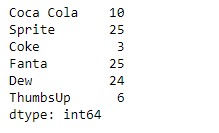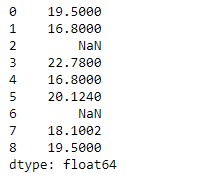Pandas 系列是带有轴标签的一维ndarray。标签不必是唯一的,但必须是可哈希的类型。该对象同时支持基于整数和基于标签的索引,并提供了许多方法来执行涉及索引的操作。
Pandas Series.mean()函数返回给定Series对象中基础数据的平均值。
用法: Series.mean(axis=None, skipna=None, level=None, numeric_only=None, **kwargs)
参数:
axis:要应用的函数的轴。
skipna:计算结果时排除NA /null值。
level:如果轴是MultiIndex(分层),则沿特定级别计数,并折叠成标量。
numeric_only:仅包括float,int,boolean列。
**kwargs:要传递给函数的其他关键字参数。
返回:均值:标量或系列(如果指定级别)
范例1:采用Series.mean()函数查找给定系列对象中基础数据的均值。
# importing pandas as pd
import pandas as pd
# Creating the Series
sr = pd.Series([10, 25, 3, 25, 24, 6])
# Create the Index
index_ = ['Coca Cola', 'Sprite', 'Coke', 'Fanta', 'Dew', 'ThumbsUp']
# set the index
sr.index = index_
# Print the series
print(sr)输出:

现在我们将使用Series.mean()函数查找给定系列对象的均值。
# return the mean
result = sr.mean()
# Print the result
print(result)输出:

正如我们在输出中看到的,Series.mean()函数已成功返回给定系列对象的均值。
范例2:采用Series.mean()函数查找给定系列对象中基础数据的均值。给定的系列对象还包含一些缺失值。
# importing pandas as pd
import pandas as pd
# Creating the Series
sr = pd.Series([19.5, 16.8, None, 22.78, 16.8, 20.124, None, 18.1002, 19.5])
# Print the series
print(sr)输出:

现在我们将使用Series.mean()函数查找给定系列对象的均值。我们将在计算均值时跳过所有缺失值。
# return the mean
# skip all the missing values
result = sr.mean(skipna = True)
# Print the result
print(result)输出:

正如我们在输出中看到的,Series.mean()函数已成功返回给定系列对象的均值。
相关用法
- Python pandas.map()用法及代码示例
- Python Pandas Series.str.len()用法及代码示例
- Python Pandas.factorize()用法及代码示例
- Python Pandas TimedeltaIndex.name用法及代码示例
- Python Pandas dataframe.ne()用法及代码示例
- Python Pandas Series.between()用法及代码示例
- Python Pandas DataFrame.where()用法及代码示例
- Python Pandas Series.add()用法及代码示例
- Python Pandas.pivot_table()用法及代码示例
- Python Pandas Series.mod()用法及代码示例
- Python Pandas Dataframe.at[ ]用法及代码示例
- Python Pandas Dataframe.iat[ ]用法及代码示例
- Python Pandas.pivot()用法及代码示例
- Python Pandas dataframe.mul()用法及代码示例
- Python Pandas.melt()用法及代码示例
注:本文由纯净天空筛选整理自Shubham__Ranjan大神的英文原创作品 Python | Pandas Series.mean()。非经特殊声明,原始代码版权归原作者所有,本译文未经允许或授权,请勿转载或复制。
